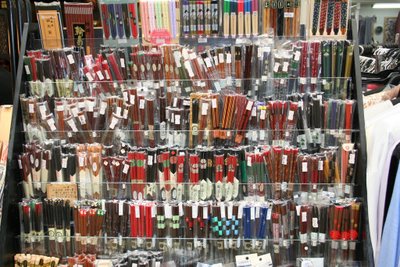Chopsticks・お箸
In my life I have met two types of non-Asians: those who are enthusiastic about using chopsticks and those who avoid it like the plague.
In my life I have met two types of non-Asians: those who are enthusiastic about using chopsticks and those who avoid it like the plague.

For those of us who did not grow up using chopsticks, the concept can be daunting. I find it amusing, though, that I have several Japanese friends who would prefer a fork to chopsticks. Anytime I am with a group of Asians and one person asks for a fork, the result is one of two situations:
1. The server brings one fork and gives it to me since I’m the token white chick.
2. The server brings two forks, one for me and one for the person who really wanted one.
It’s interesting to see how culture forms people, how it is ingrained in us without our recognition. When I cook Japanese food, I use chopsticks: for mixing, for frying, etc. That’s how I learned to do it; that’s the way it’s supposed to be done. I’ll never forget when I went home after my first year in Japan. My mother laughed out loud when she saw me beating an egg with chopsticks. It had never occurred to me to do it any other way because I was preparing a Japanese dish. But, by the same token, it doesn’t occur to me to pick up a pair of chopsticks to perform the same task when making Western food.
If you catch me in Japan and ask to look in my bag, most likely you will find a pair of chopsticks stashed in there so that I can avoid using waribashi (割り箸), wooden throw-away chopsticks. No Japanese person I know does that, but they all think it’s great that I do. I love my chopsticks (all twenty or so pairs that I have), and I can’t imagine what I would do without them.


0 Comments:
Post a Comment
<< Home